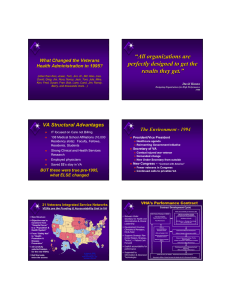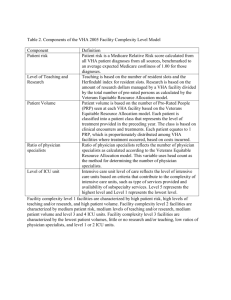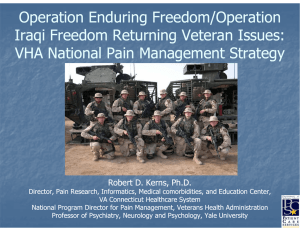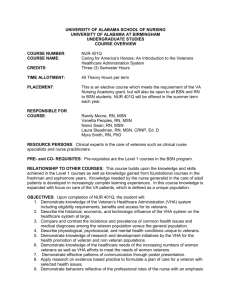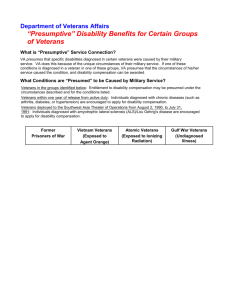Outcomes Evaluation of a Program using Myofascial Techniques for
advertisement
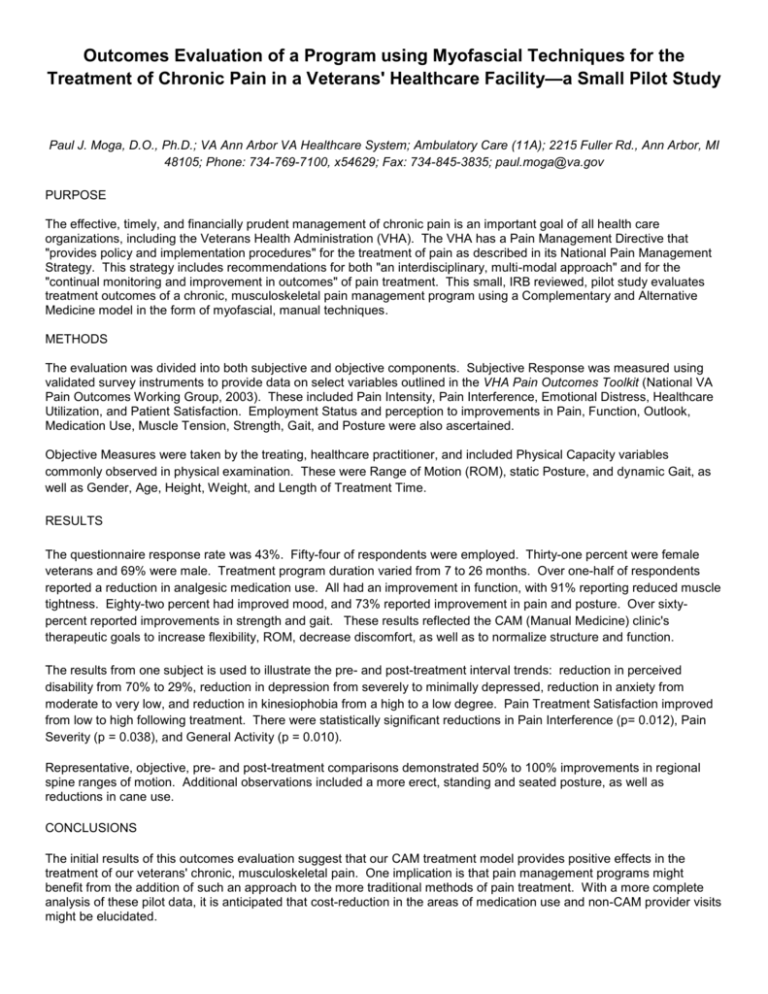
Outcomes Evaluation of a Program using Myofascial Techniques for the Treatment of Chronic Pain in a Veterans' Healthcare Facility—a Small Pilot Study Paul J. Moga, D.O., Ph.D.; VA Ann Arbor VA Healthcare System; Ambulatory Care (11A); 2215 Fuller Rd., Ann Arbor, MI 48105; Phone: 734-769-7100, x54629; Fax: 734-845-3835; paul.moga@va.gov PURPOSE The effective, timely, and financially prudent management of chronic pain is an important goal of all health care organizations, including the Veterans Health Administration (VHA). The VHA has a Pain Management Directive that "provides policy and implementation procedures" for the treatment of pain as described in its National Pain Management Strategy. This strategy includes recommendations for both "an interdisciplinary, multi-modal approach" and for the "continual monitoring and improvement in outcomes" of pain treatment. This small, IRB reviewed, pilot study evaluates treatment outcomes of a chronic, musculoskeletal pain management program using a Complementary and Alternative Medicine model in the form of myofascial, manual techniques. METHODS The evaluation was divided into both subjective and objective components. Subjective Response was measured using validated survey instruments to provide data on select variables outlined in the VHA Pain Outcomes Toolkit (National VA Pain Outcomes Working Group, 2003). These included Pain Intensity, Pain Interference, Emotional Distress, Healthcare Utilization, and Patient Satisfaction. Employment Status and perception to improvements in Pain, Function, Outlook, Medication Use, Muscle Tension, Strength, Gait, and Posture were also ascertained. Objective Measures were taken by the treating, healthcare practitioner, and included Physical Capacity variables commonly observed in physical examination. These were Range of Motion (ROM), static Posture, and dynamic Gait, as well as Gender, Age, Height, Weight, and Length of Treatment Time. RESULTS The questionnaire response rate was 43%. Fifty-four of respondents were employed. Thirty-one percent were female veterans and 69% were male. Treatment program duration varied from 7 to 26 months. Over one-half of respondents reported a reduction in analgesic medication use. All had an improvement in function, with 91% reporting reduced muscle tightness. Eighty-two percent had improved mood, and 73% reported improvement in pain and posture. Over sixtypercent reported improvements in strength and gait. These results reflected the CAM (Manual Medicine) clinic's therapeutic goals to increase flexibility, ROM, decrease discomfort, as well as to normalize structure and function. The results from one subject is used to illustrate the pre- and post-treatment interval trends: reduction in perceived disability from 70% to 29%, reduction in depression from severely to minimally depressed, reduction in anxiety from moderate to very low, and reduction in kinesiophobia from a high to a low degree. Pain Treatment Satisfaction improved from low to high following treatment. There were statistically significant reductions in Pain Interference (p= 0.012), Pain Severity (p = 0.038), and General Activity (p = 0.010). Representative, objective, pre- and post-treatment comparisons demonstrated 50% to 100% improvements in regional spine ranges of motion. Additional observations included a more erect, standing and seated posture, as well as reductions in cane use. CONCLUSIONS The initial results of this outcomes evaluation suggest that our CAM treatment model provides positive effects in the treatment of our veterans' chronic, musculoskeletal pain. One implication is that pain management programs might benefit from the addition of such an approach to the more traditional methods of pain treatment. With a more complete analysis of these pilot data, it is anticipated that cost-reduction in the areas of medication use and non-CAM provider visits might be elucidated.
